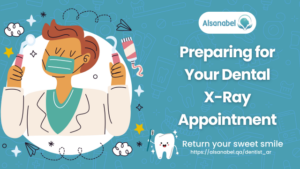Visiting the dentist, especially for dental radiographs or X-rays, can be nerve-wracking. However, understanding the process can alleviate anxiety and ensure a smoother experience. Dental radiographs are crucial for diagnosing dental issues and planning treatment, so it’s important for patients to understand how they can help capture high-quality images. This includes knowing how to prepare, what to expect, and being aware of infection control measures. With this knowledge, patients can feel more comfortable and procedures can be more efficient. In this guide, we’ll provide essential tips to help patients navigate their dental radiography appointments confidently.
Table of Contents
Toggle1-Preparing for Your Dental X-Ray Appointment
Preparing for a dental X-ray appointment at best dental clinic in Qatar is straightforward, but there are a few key steps to ensure everything goes smoothly:

- Confirm Appointment Details: Double-check the date, time, and location of your appointment to ensure you arrive on time.
- Arrive Early: Aim to arrive at least 10-15 minutes early to allow for any unexpected delays.
- Bring Necessary Documents: If you’re a new patient, bring dental insurance information, identification, and any requested documents.
- Wear Comfortable Clothing: Dress in clothing that’s easy to adjust, as you may be asked to wear a protective lead apron during the procedure.
- Inform Your Dentist of Concerns: Let your dentist know about any existing dental issues, health conditions, or if you’re pregnant, so they can adjust the procedure if needed.
- Remove Jewelry and Accessories: Take off any jewelry, glasses, or metal accessories that might interfere with the imaging process.
- Follow Instructions: Listen carefully to instructions from your dentist or dental assistant to ensure accurate results and your safety during the X-ray procedure.
- Stay Calm and Relaxed: Remember that dental X-rays are painless and quick. If you’re anxious, let your dental team know so they can provide support.
- Ask Questions: Feel free to ask any questions or voice concerns about the X-ray procedure to your dentist or dental assistant at our dental center.
- Follow Up: After the X-rays are taken, your dentist will review the images and discuss any findings with you. Follow any further instructions they provide, such as scheduling follow-up appointments or additional treatments if necessary.
2-Minimizing Radiation Exposure
Minimizing radiation exposure during dental radiographs is crucial for both patients and dental professionals. Here are key strategies:
- Digital Radiography: Digital systems reduce radiation compared to traditional X-rays, providing clearer images for accurate diagnoses.
- Proper Shielding: Lead aprons and thyroid collars shield organs from radiation. Ensuring correct positioning maximizes protection.
- Collimation: Restricting the X-ray beam to the area of interest minimizes exposure to surrounding tissues, enhancing safety.
- Fast Film Speed: Using fast film reduces exposure time, decreasing radiation exposure during traditional X-ray procedures.
- Limit Frequency: X-rays should be taken only when necessary, following guidelines to avoid unnecessary exposure.
- Protective Barriers: Dental professionals should minimize exposure by standing behind barriers or leaving the room during X-rays.
- Patient Education: Educating patients on X-ray benefits and risks assures them of modern safety measures, fostering informed decision-making.
- Pediatric and Pregnancy Considerations: Special attention is given to pediatric patients and pregnant individuals to minimize radiation risks through proper equipment use and adjusted exposure settings.
- Regular Maintenance: Routine equipment maintenance and calibration ensure accurate imaging and lower radiation doses, maintaining safety standards.
By implementing these measures, both patients and dental professionals at our dental center can mitigate radiation risks associated with dental radiography effectively.
3-Discussing Your Needs with the Dentist
Open and effective communication with your dentist at best dental clinic in Qatar is essential for receiving quality dental care. Here are key tips for discussing your needs with your dentist:
- Be Honest: Share your dental concerns, medical history, and any fears openly to help your dentist understand your needs better.
- Ask Questions: Inquire about your treatment options, procedures, and outcomes to alleviate anxiety and make informed decisions.
- Express Concerns: If you’re anxious about dental procedures, let your dentist know. They can offer reassurance and adjust their approach to help you feel more comfortable.
- Discuss Preferences: Talk to your dentist about your treatment preferences, whether it’s conservative options, cosmetic dentistry, or specific technologies.
- Share Goals: Communicate your dental goals, such as improving your smile or addressing pain, to work with your dentist on a personalized treatment plan.
- Address Financial Concerns: Discuss financial options and payment plans with your dentist at the best dental clinic in Qatar to ensure dental care fits your budget.
- Follow Recommendations: Consider your dentist’s recommendations for treatment and preventive care to maintain optimal oral health.
- Provide Feedback: Share feedback about your dental care experience to help your dentist improve services and ensure your needs are met.
- Schedule Regular Check-ups: Maintain regular communication by scheduling dental check-ups and preventive care appointments to address any new concerns and stay proactive about your oral health.
4-Safety Measures during Dental Radiographs
Safety measures during dental radiographs at our dental center are vital to reduce radiation exposure for patients and dental professionals. Key measures include:
- Protective Gear: Patients should wear lead aprons and thyroid collars to shield organs from radiation, ensuring proper positioning for effective protection.
- Fast Film Speed or Digital Radiography: Using fast film speed or digital radiography minimizes exposure time and radiation dose, offering clearer images and immediate processing.
- Collimation: Dentists use collimators to focus the X-ray beam on specific areas, reducing unnecessary exposure to surrounding tissues.
- Positioning and Technique: Accurate positioning of both equipment and patients ensures clear images with minimal scatter radiation. Proper exposure settings are crucial for low radiation doses.
- Pediatric Considerations: Special attention is given to pediatric patients, utilizing child-size protective gear and exposure settings to minimize radiation while maintaining diagnostic quality.
- Pregnant Patients: Pregnant patients should inform their dentist to avoid unnecessary X-rays. If required, additional shielding is provided to minimize fetal exposure.
- Distance and Time: Dental staff maintain a safe distance and minimize exposure time during X-ray procedures, reducing radiation exposure.
- Regular Equipment Maintenance: Routine maintenance and calibration of X-ray equipment ensure accurate imaging and lower radiation doses, maintaining safety standards.
- Patient Education: Patients are informed about the benefits and risks of dental X-rays, reassuring them of safety measures and addressing any concerns.
- Regulatory Compliance: Dental practices adhere to regulatory guidelines, ensuring equipment standards, quality assurance, and staff training for radiation safety.
5-Post-Radiograph Follow-up
Following a dental radiographs, it’s essential to understand the results and any necessary follow-up steps. Here’s a guide to post-radiograph follow-up:

- Review Results: Your dentist will assess the radiograph images to spot any issues or abnormalities in your oral health.
- Discuss with Dentist: Schedule a follow-up to go over the results. Your dentist will explain findings, address queries, and discuss treatment options.
- Treatment Planning: Based on radiograph findings, your dentist may recommend treatments to resolve any identified dental issues.
- Preventive Measures: Your dentist might suggest preventive measures or lifestyle changes to enhance your oral health.
- Monitoring: Regular monitoring or follow-up dental radiographs may be advised to track changes in your oral health.
- Address Concerns: Discuss any concerns about the results or treatments with your dentist during the follow-up appointment.
- Schedule Future Appointments: Arrange any necessary follow-up appointments for treatments, monitoring, or preventive care.
- Maintain Oral Hygiene: Keep up with good oral hygiene practices like brushing, flossing, and regular dental check-ups to uphold your oral health between appointments.
